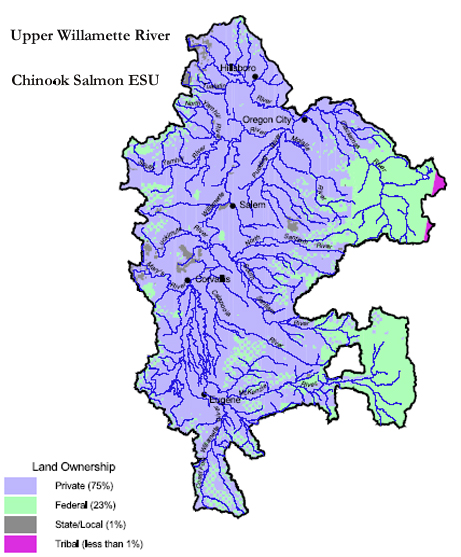Artificial Salmon Runs in the Willamette Basin
The Chinook salmon in the Willamette River system are considered one of the most threatened “Distinct Population Segments” in the Pacific Northwest. Yet historically, there were very few salmon in the Willamette. The reason: Willamette Falls, 26 miles upstream the confluence with the Columbia, was mostly impassable to upstream-bound fish.
Willamette Falls is 42 feet high and flows over a sheer natural rock formation. It was a natural barrier to fish passage. Only in spring flood, and not every year, could a few Chinook salmon make the leap. From PGE (who runs the power dam there today) [here]:
In 1885 the first fish ladder was excavated out of the solid rock. Though primitive, this ladder did help fish move above the falls. Technology and knowledge of fisheries advanced over time, and the Oregon Department of Fish and Wildlife designed the current fish ladder, which was completed in 1971.
In the early 1900’s seven Willamette Basin salmon hatcheries were established: McKenzie River, Marion Forks/North Fork Santiam River, South Santiam in the South Fork Santiam River, South Santiam in the Calapooia River, South Santiam in the Mollala River, Willamette, and Clackamas hatcheries. Salmon returning to the hatcheries to breed after their oceanic sojourns swam up through the fish ladder at Willamette Falls.
In 1999 the artificial Willamette River salmon population was declared an endangered species [here].
UPPER WILLAMETTE RIVER CHINOOK ESU THREATENED
ESU STATUS AND DESCRIPTION: Listed as threatened on March 24, 1999; threatened status reaffirmed on June 28, 2005. The ESU includes all naturally spawned populations of spring-run Chinook salmon in the Clackamas River and in the Willamette River, and its tributaries, above Willamette Falls, Oregon, as well as seven artificial propagation programs…
Environmentalists applauded the listing, claiming that [here]:
The Upper Willamette River Chinook species includes native spring-run populations above Willamette Falls and in the Clackamas River. Of the historical populations, 8 to 10 have been extirpated or nearly extirpated. Natural production currently occurs in approximately 20 populations, although only one population has a mean spawner abundance exceeding 1,000 fish.
Somehow 20 to 30 natural “populations” of salmon were discovered in 1999. No one noticed that a century before there were none, or possibly one peripatetic, spring-run Chinook population.
The Willamette River is 187 miles long and the Basin is 11,100 square miles in extent. A subset of the area, including all the privately-owned land, has been “identified” as prime natural salmon spawning habitat.

Numerous sloughs and sluggish rivers meander slowly into the Willamette River, including the Long Tom, Pudding, Marys, and Luckimute Rivers and many more. Historically these tributaries were quite warm in summer months, too warm for salmon. But since the listing, all these have been tagged as “polluted” by warm water, based on “findings” by government “scientists.”
Numerous millions of dollars have been spent to cool these rivers, typically by planting brush along river banks with absolutely no effect on water temperatures. A better idea, one that might work, is to install thousands of ice machines to dump ice cubes directly into the warm waters all summer long. However, the only way to get power to run the ice machines is through hydroelectric dams (the Corps of Engineers manages 13 Willamette Basin reservoirs). But the reservoirs warm the water. It’s Catch-22!
Catch-22 is a good description of the Endangered Species Act. Just as in Joseph Heller’s great novel, nonsense and absurdity accompany man’s inhumanity to man. The attribution of “naturalness” to artificial salmon runs is a fish slap in the face to Willamette Valley residents and landowners.
Get taxed to death and have your property rights seized, all in the name of pseudo-scientific fakery and revisionist history! Save the recent artificial fish! Do it for Mother Nature. If you don’t, we’ll be the next species to go extinct. Or so the eco-nazis would have you believe.
